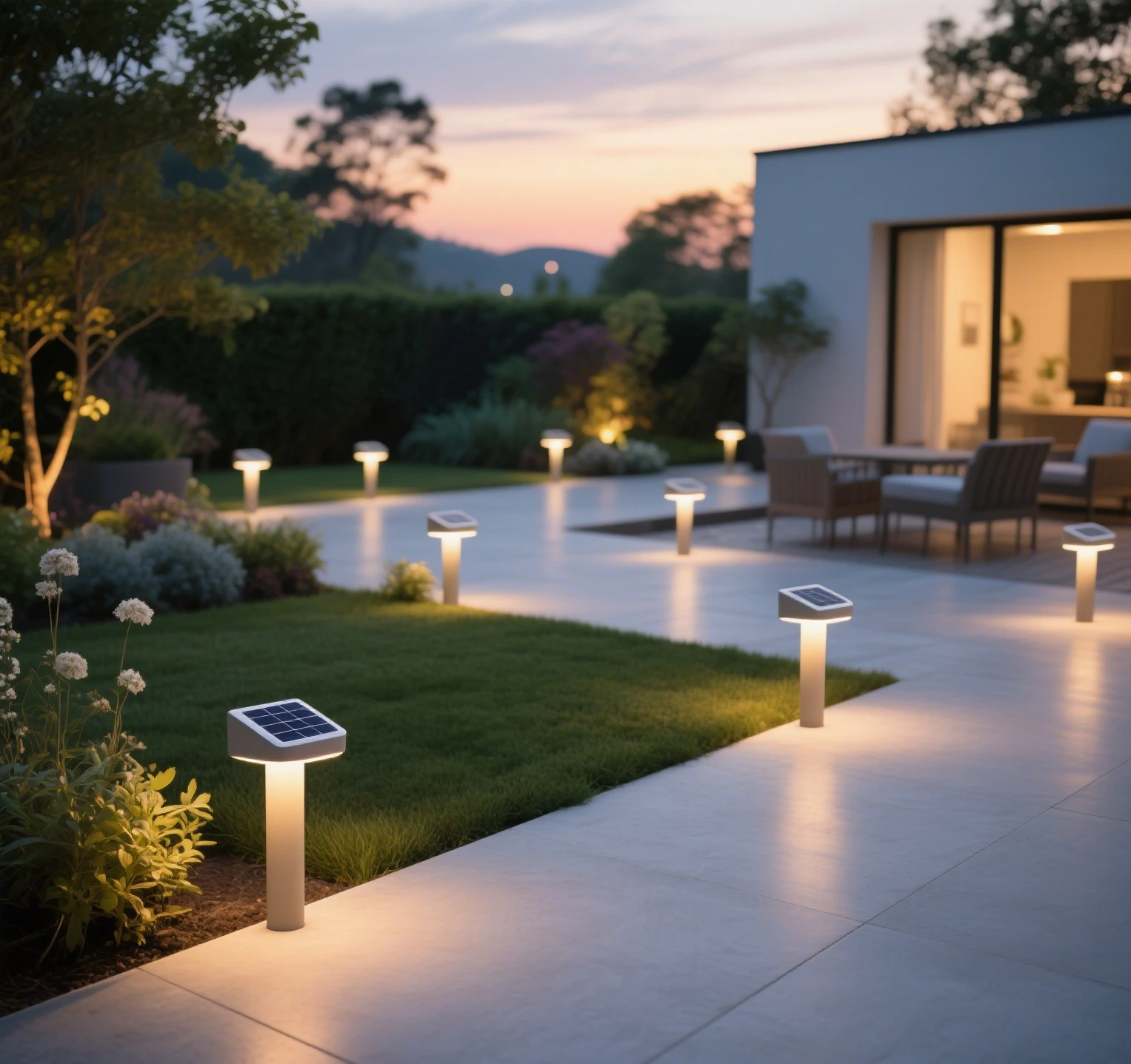As we approach 2025, the outdoor lighting industry is undergoing a transformative shift, driven by advancements in technology, a growing emphasis on sustainability, and the increasing integration of smart home ecosystems. Among the most promising innovations are motion-sensor solar path lights, which combine energy efficiency, convenience, and smart functionality to redefine how we illuminate outdoor spaces. These lights not only enhance the aesthetic and functional aspects of gardens, walkways, and patios but also align with global sustainability goals and the rising demand for connected, intelligent home systems. By leveraging solar power and motion-sensor technology, these lights offer a glimpse into the future of outdoor lighting, with seamless integration into platforms like Amazon Alexa and Google Assistant, as highlighted by industry predictions from sources like Consumer Reports and Grand View Research. This article explores the benefits of motion-sensor solar path lights, their role in smart home ecosystems, and their contribution to sustainable living, while also looking ahead to emerging trends in 2025 and beyond.
The Rise of Motion-Sensor Solar Path Lights
Motion-sensor solar path lights represent a significant leap forward in outdoor lighting technology. Unlike traditional lighting solutions that rely on constant power or manual operation, these lights harness solar energy during the day to power energy-efficient LED bulbs at night, activating only when motion is detected. This dual approach—solar power and motion sensors—addresses two critical consumer needs: energy efficiency and convenience. According to Grand View Research, the global outdoor lighting market is projected to grow at a compound annual growth rate (CAGR) of 9.4% from 2025 to 2030, driven by the adoption of energy-efficient technologies like LED and solar lighting. Motion-sensor solar path lights are at the forefront of this growth, offering a sustainable alternative to traditional grid-powered lights.

The primary advantage of these lights is their ability to reduce energy consumption. By activating only when motion is detected, they minimize unnecessary illumination, conserving energy and extending battery life. Products like the URPOWER Solar Lights and LITOM Solar Landscape Spotlights, as noted in industry reviews, feature high-efficiency solar panels and long-lasting LEDs, ensuring reliable performance while reducing reliance on traditional electricity. This not only lowers electricity costs for homeowners but also aligns with global sustainability initiatives aimed at reducing carbon emissions, as highlighted in Nature journal’s analysis of LED lighting’s impact on global energy consumption.
Integration with Smart Home Ecosystems
One of the most exciting trends for 2025 is the seamless integration of motion-sensor solar path lights with smart home ecosystems. As smart home adoption grows—Statista projects the smart home market to reach USD 250 billion in 2025—these lights are becoming integral components of connected living spaces. Compatibility with platforms like Amazon Alexa, Google Assistant, Apple HomeKit, and Samsung SmartThings allows users to control their outdoor lighting through voice commands or smartphone apps. For instance, brands like Ring and Philips Hue offer solar-powered path lights that sync with Alexa, enabling users to adjust brightness, set schedules, or activate lights with simple commands like, “Alexa, turn on the garden lights.”
This integration enhances both convenience and security. Motion-sensor technology allows lights to activate automatically when someone approaches, deterring potential intruders and improving visibility in outdoor areas. Wirecutter notes that smart models, such as the Ring Solar Pathlight, send alerts to users’ phones when motion is detected, adding an extra layer of security by notifying homeowners of activity in their yard. Additionally, these lights can be programmed to work in tandem with other smart devices, such as security cameras or doorbells, creating a cohesive smart home ecosystem. For example, a motion sensor detecting activity can trigger a Ring camera to start recording, as highlighted in CNET’s review of Ring’s solar-powered path lights.
The incorporation of Internet of Things (IoT) technology further enhances functionality. IoT-enabled solar path lights can adjust brightness based on ambient light conditions or occupancy, optimizing energy use. According to Grand View Research, the smart lighting market, including IoT-enabled solutions, is expected to grow at a CAGR of 25% through 2028, reflecting the increasing demand for intelligent, adaptive lighting systems. This trend is particularly relevant for outdoor applications, where energy efficiency and automation are critical for both residential and commercial spaces.
Sustainability and Environmental Impact
Sustainability is a driving force behind the adoption of motion-sensor solar path lights. As global awareness of environmental issues grows, consumers and manufacturers are prioritizing eco-friendly solutions. These lights leverage renewable solar energy, reducing dependence on fossil fuel-based electricity. Consumer Reports and other industry sources emphasize that solar-powered LED lights contribute to a significant reduction in carbon footprints, aligning with initiatives like the European Union’s Ecodesign Directive and Canada’s Green Infrastructure Fund. By using recyclable materials and energy-efficient LEDs, manufacturers are further minimizing environmental impact, as noted in Lumarysmart’s analysis of sustainable lighting trends.
The use of motion sensors enhances sustainability by ensuring lights are only active when needed. This feature is particularly valuable in outdoor settings, where constant illumination can lead to unnecessary energy consumption. For instance, Nite Lite recommends placing motion sensors strategically to maximize energy savings, such as along pathways or near entry points. Additionally, advancements in solar panel technology, such as lightweight and flexible photovoltaic cells, allow for sleeker designs that blend seamlessly into outdoor aesthetics while maintaining high efficiency, as discussed in Godpowerssolar’s 2025 trends report.
Enhancing Outdoor Aesthetics and Functionality
Beyond their technical benefits, motion-sensor solar path lights enhance the aesthetic appeal and functionality of outdoor spaces. Available in a variety of designs, from minimalist to sculptural, these lights cater to diverse consumer preferences. Lumarysmart highlights products like the Lumary Smart RGBAI Pathway Lights Pro, which offer color-changing capabilities and customizable settings, allowing homeowners to create vibrant, personalized outdoor environments. Whether illuminating a garden path or accentuating architectural features, these lights combine form and function to elevate outdoor living spaces.
The rise of outdoor living trends, such as patios and terraces, has fueled demand for decorative lighting that enhances ambiance while ensuring safety. Wirecutter notes that path lights improve safety on uneven or poorly lit walkways, reducing the risk of trips and falls. Motion sensors add an extra layer of functionality by activating lights only when needed, creating a welcoming atmosphere for evening gatherings without wasting energy. This balance of aesthetics and practicality makes motion-sensor solar path lights a versatile solution for modern homeowners.

Industry Predictions and Future Innovations
Looking ahead to 2025 and beyond, industry experts predict continued advancements in motion-sensor solar path lights. Consumer Reports and Grand View Research anticipate that improvements in battery storage and AI-driven controls will enhance performance and efficiency. For example, AI-based lighting systems could analyze usage patterns to optimize brightness and color temperature, creating personalized lighting experiences while further reducing energy consumption. Additionally, the integration of Li-Fi technology, which uses light for high-speed data transmission, could transform outdoor lighting into a multifunctional component of smart city infrastructure, as noted in Marketsandmarkets.
Another emerging trend is the use of sustainable materials, such as recycled plastics and bamboo, in lighting fixtures. Godpowerssolar reports that manufacturers are increasingly prioritizing eco-friendly materials to meet consumer demand for greener products. These innovations not only reduce environmental impact but also appeal to eco-conscious buyers seeking stylish, sustainable solutions. Furthermore, the expansion of smart city initiatives, such as India’s Smart Cities Mission, is expected to drive demand for solar-powered, IoT-enabled lighting systems in public spaces, creating opportunities for widespread adoption.
Challenges and Considerations
Despite their many benefits, motion-sensor solar path lights face some challenges. The initial cost of smart lighting systems, including installation and software, can be higher than traditional options, as noted in Grand View Research. However, long-term savings from reduced energy consumption and lower maintenance costs often offset these expenses. Additionally, the effectiveness of solar lights depends on adequate sunlight exposure, which may be a limitation in regions with limited daylight. Advances in battery technology and more efficient solar panels are addressing these concerns, ensuring reliable performance even in less sunny climates.
Another consideration is the need for compatibility with existing smart home systems. While most modern solar path lights support major platforms like Alexa and Google Assistant, some may have limited integrations, such as lacking support for Apple HomeKit, as highlighted in Wirecutter’s reviews. Consumers should carefully evaluate compatibility and app functionality to ensure a seamless user experience.
Conclusion
Motion-sensor solar path lights are poised to shape the future of outdoor lighting, offering a powerful combination of energy efficiency, smart home integration, and sustainability. As the global outdoor lighting market continues to grow, driven by consumer demand for eco-friendly and intelligent solutions, these lights stand out as a versatile and forward-thinking option. Their ability to integrate with platforms like Alexa and Google Assistant, coupled with their use of renewable solar energy and motion-sensor technology, makes them an ideal choice for homeowners seeking to enhance both the functionality and aesthetics of their outdoor spaces. With ongoing innovations in AI, battery storage, and sustainable materials, the future of motion-sensor solar path lights looks brighter than ever, promising a more connected, efficient, and environmentally conscious approach to outdoor illumination.







Leave a Reply